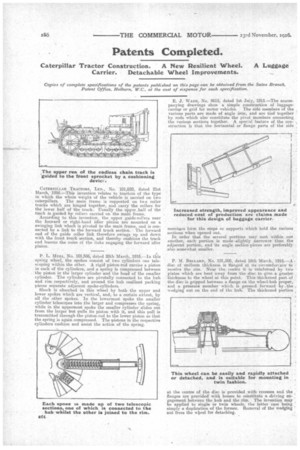Patents Completed.
Page 24

If you've noticed an error in this article please click here to report it so we can fix it.
Caterpillar Tractor Construction. A New Resilient Wheel. A Luggage Carrier. Detachable Wheel Improvements.
Copies of complete specifications of the patents published on this page can be obtained from the Sales Branch, Patent Office, Holborn, W.C., at the cost of sixpence for each specification.
CATERPILLAR TRACTORS, LTD., No. 101,692, dated 21st March, 1916.—This invention relates to 'tractors of the type in which the whole weight of the vehicle is carried on two
caterpillars. The main frame is supported on tv.o roller trucks which are hinged together, and carry the rollers for the lower half of the track. Usually the upper _half of the tsack is guided by rollers carried on the main frame. According to this invention, the upper guide-rollers near the forward or right-hand idler pinion are mounted on a swinging link which is pivoted to the main frame, and is connected by a link to the forward truck section. The forward end of the guide roller link therefore swings up and down with the front truck section, and thereby cushions the track and lessens the noise of the links engaging the forward idler pinion.
P. L. MusA, No. 101,586, dated 28th March, 1916.—In this spring wheel, the spokes consist of two cylinders one telescoping within the other. A rigid :piston-rod carries a piston in each of the cylinders, and a spring is compressed between the piston in the larger cylinder and the head of the smaller cylinder. The cylinders are pivotally connected to the hub and rim respectively, and around the hub resilient packing pieces separate adjacent spoke-cylinders. Shock is absorbed in this wheel by both the upper and lower spokes which are vertical, and, to a certain extent, by all the other spokes. In the lowermost spoke the smaller cylinder telescopes into the larger and compresses the spring, while in the uppermost spoke the smaller cylinder slides out from the larger but pulls its piston with it, and this pull is transmitted through the piston-rod to the lower piston so that the spring is again compressed. The pistons in the respective cylinders cushion and assist the action of the spring. E. J. WADE, No. 9615, dated 1st July, 1915,—The accompanying drawings show a simple construction of luggagecarrier or grid for motor vehicles. The Side members of the various parts are made of angle iron, and are tied together by rods which also constitute the pivot members connecting the various sections together. A special feature of the construetion is that the horizontal or flange parts of the side members form the stops or supports which hold the various sections when opened out. In order that. the several portions may nest within one another, each' portion is made 'slightly narrower than the adjacent portion, and its angle section-pieces are preferably also somewhat smaller.
P. M. BELLARD, No. 101,508, dated 18th March, 1916.—A . disc of nniform thickness is flanged at its eircumfercn'ec lo receive the rim. Near the centre it is reinforced by tWoplates which are bent away from the disc to give a greater thickness to the wheel at this point. This thickened part of the disc is gripped between a flange on the wheel-hub proper, and a pressure member which is pressed • forward by the , wedging nut on the end of the hub. The thickened portion at the centre of the disc is' provided with recesses and the flanges are provided with bosses to constitute a driving en:.` gagement between the hub and the rim. The invention may be applied to single or twin wheels, the latter case being simply a duplication of the former. Removal of the wedging nut frees the wbeel for detaching.
























